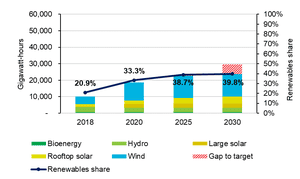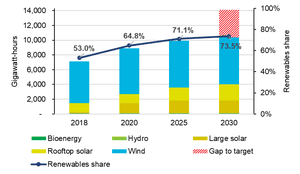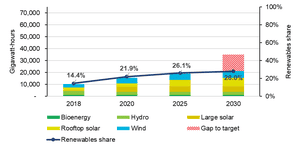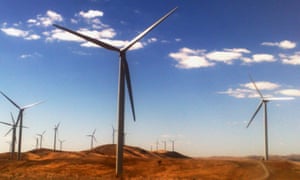State governments seem frustrated with the Coalition – but we are closer to 100% renewables than you think
Shortly after its re-election, the Morrison federal government
confirmed it would not consider a new policy to reduce carbon emissions
from Australia’s electricity sector.
Meanwhile, every state government within the national electricity market has either a target to increase the share of renewable energy or substantially reduce its emissions. This includes both Labor and Liberal party-governed states.
So how are the states going in reaching their targets?
Victoria at least is doing pretty well. The chart below illustrates the amount of renewable energy being generated in Victoria by fuel type and Green Energy Markets’ projections of how it will change out to 2030. This is based on a combination of large utility-scale projects either in operation, construction or contracted plus growth in rooftop solar expected by the Australian Energy Market Operator.
Victorian renewable energy by year and share of total generation

Meanwhile, every state government within the national electricity market has either a target to increase the share of renewable energy or substantially reduce its emissions. This includes both Labor and Liberal party-governed states.
So how are the states going in reaching their targets?
Victoria at least is doing pretty well. The chart below illustrates the amount of renewable energy being generated in Victoria by fuel type and Green Energy Markets’ projections of how it will change out to 2030. This is based on a combination of large utility-scale projects either in operation, construction or contracted plus growth in rooftop solar expected by the Australian Energy Market Operator.
Victorian renewable energy by year and share of total generation

That shouldn’t be hard to achieve. Last year it completed a tender to contract 650 megawatts of projects which actually ended up delivering 928 megawatts of projects. During that tender it received proposals for over 3500MW of projects. So just another two tender rounds could be enough to get Victoria to 50% renewables.
South Australia has also achieved pretty staggering progress in the last few years, with renewables generating greater than half the state’s electricity consumption last year. By 2030 it will have reached 73.5%. But this still leaves the state short of the Liberal government’s target for 100% net renewables by 2030 – where any fossil fuel use is offset by extra renewable energy exports. We estimate another 1,300 megawatts would lift them to 100%.
South Australian renewable energy by year and share of total consumption

Queensland will double the share of its demand met by renewables in just two years from 10.7% to 21.4% by 2020. After that though, progress slows. The government’s new power company, CleanCo, will help continue to drive growth but it isn’t enough to reach the state’s target of 50% renewables by 2030. CleanCo has been tasked with procuring 1,000 megawatts of renewables but the state needs far more – 5,500 megawatts – to reach 50%. Given the state managed to commit 2,700 megawatts to construction in the last three years, there’s no physical challenge to constructing 5,500 megawatts over the next 10 years.
Queensland renewable energy by year and share of total consumption

But present project commitments plus rooftop solar only deliver 28% renewables, and the state needs to stimulate another 5,000 megawatts of projects to get back on track.
NSW renewable energy by year and share of total consumption

State governments appear to understand and share this frustration. This was evident in a recent speech given by NSW’s energy minister, Matt Kean, and also revealed in an interview South Australia’s energy minister Dan van Holst Pellekaan gave to the Guardian.
Yet constitutional power for the power sector rests with state governments, not the federal government. They have full legal authority to implement something like the national energy guarantee or indeed some better policy to lower emissions. Continuing to point the finger at the federal government will get us no closer to a policy that supports ongoing investment in the electricity sector, reduced emissions and lower electricity prices.
The states are not that far apart in what they say they want to achieve. The power is within their own hands to deliver it.
- Tristan Edis is director of analysis and advisory at Green Energy Markets

No comments:
Post a Comment